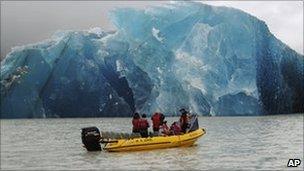Christchurch quake: Ice chunks fall from Tasman Glacier
- Published

The Christchurch earthquake could have triggered huge ice falls 200km away on the Tasman Glacier
The Christchurch earthquake may have caused 30 million tonnes of ice to fall off the Tasman Glacier, on the other side of New Zealand's South Island.
The huge amount of ice has broken into icebergs now floating in the Tasman Lake; one is 250m (275 yards) long.
It had been expected that the ice would break one day but there was surprise a quake may have triggered the fall.
The Tasman Glacier is 200km (125 miles) away from Christchurch, near the west coast of the South Island.
The piece of ice dislodged was 1.2km (0.75 mile) long, 300m (330 yards) high and 75m (80 yards) wide.
It fell off the face of Tasman Glacier, in Aoraki/Mount Cook National Park, on Tuesday afternoon, soon after the earthquake struck Christchurch.
The general manager of the Aoraki Mt Cook Alpine Village, Denis Callesen, said recent heavy rainfall in the area had made the ice chunk vulnerable.
"The earthquake that we felt here was a swaying motion for about a minute, then it stopped and then it swayed for about another minute," he told the AFP news agency.

The glacier's ice shears have attracted tourists on to Tasman Lake
"Within about a minute of that happening, the staff at the lake heard from 5km away a sound that sounded like a rifle shot and then over the next two minutes all the events started to unfold.
"I have absolutely no doubt in my mind that the earthquake was the trigger."
The Department of Conservation was more cautious about blaming the fall directly on the quake.
"You could argue whether the earthquake precipitated it or not - the fact is that the terminal face was about due to calve anyway," area manager Richard McNamara told AFP.
A group of tourists on a boat in the lake at the time were hit by giant waves created by the calving.
Mr Callesen said they had not been in danger and had the trip of a lifetime.
This was estimated to be the third largest calving to have occurred in the lake in the last 40 years.
All three happened in the past two years.